William Norris, New Mexico State University, wnorris1@nmsu.edu
Lacey Roberts-Hill, New Mexico State University, lnrob@nmsu.edu
Abstract
Science, technology, engineering, and mathematics (STEM) has become an integral piece of agricultural education. Unfortunately, employers claim that students existing secondary and post-secondary education do not possess the necessary STEM-based skills to be successful in the workforce. Additionally, research shows inconsistent results regarding the STEM achievement of agricultural education students. These inconsistent student achievement results are coupled with gender-based disparities regarding STEM. Many female agricultural educators claim to be unconfident in their abilities to integrate some STEM concepts into the agricultural education curriculum. These issues concern the agricultural education profession, considering STEM’s importance in today’s educational environment. This study assessed the confidence of male and female agricultural educators to integrate STEM-based AFNR standards into their curriculum. A total of 399 agricultural educators were contacted in three states- [State A], [State B], and [State C]. The response rate was 17.04% and resulted in 68 responses. The results found that female agricultural educators ranked their confidence in integrating STEM statistically lower than male agricultural educators within the Environmental Services (p = .01), Food Products and Processing (p = .02), Natural Resources (p = .03), Plant Systems (p = .05), and Power, Structural, and Technical Systems pathways (p < .001). Additionally, male agricultural educators ranked the Plant Systems, Animal Science, and Power, Structural, and Technical Systems pathways as the areas they felt the most confident integrating STEM and ranked the Biotechnology, Agribusiness, and Environmental Services pathways the lowest. The female agricultural educators ranked the Animal Science, Plant Systems, and the Natural Resources pathways as the areas they had the most confidence in integrating STEM, and they ranked the Power, Structural, and Technical Systems, Environmental Services, and Biotechnology pathways the lowest. The researchers recommend targeted professional development for educators and additional research on agricultural educators’ STEM integration confidence levels.
Introduction
For more than 100 years, the agricultural industry has become more technologically advanced and has relied heavily on science, technology, engineering, and mathematics (STEM) to propel the industry forward (Swafford, 2018). As the world population grows, the agricultural industry must increase the use of technology to produce more food with fewer resources (Frióna et al., 2019). Since agricultural education’s inception, one of its main goals has been to provide a prepared workforce for the agricultural industry (Fristoe, 2017; Martinez, 2007). According to Scherer et al. (2019), “[p]rogress and prosperity within the United States, as well as its global competitiveness, cannot remain strong if young people are not STEM-literate and well prepared to enter the workforce of STEM professionals” (p. 29). To achieve this longstanding goal of a prepared and competent workforce, agricultural education must prioritize integrating STEM skills into the curriculum to remain relevant for the 21st century (Chumbley et al., 2015; Kelly & Knowles, 2016; Smith et al., 2015; Stubbs & Meyers, 2016; Swafford, 2018; Wang & Knoblock, 2020).
While the need for STEM skills in industry is well documented in the published literature (Chumbley et al., 2015; Kelly & Knowles, 2016; Swafford, 2018; Wang & Knoblock, 2020), industry reports that students exiting secondary and post-secondary education are deficient in STEM skills (McGunagle & Zizka, 2020). According to McGunagle and Zizka (2020), “employability skills… are often under-estimated and under-trained in educational institutions, and, more specifically, in Science, Technology, Engineering, and Math (STEM) education” (p. 2). This gap between employees’ STEM skills and employers’ expectations is concerning for the agricultural education profession.
While the importance of STEM integration is apparent, agricultural education has not been adequately successful in integrating STEM (Clark et al., 2013; McKim et al., 2018; Plank, 2001). There have also been mixed results in the STEM achievement of students enrolled in agricultural education (Chiasson & Burnett, 2001; Clark et al., 2013; McKim et al., 2018; Nolin & Parr, 2013; Plank, 2001; Theriot & Kotrlik, 2009). Some researchers found that student achievement in science is significantly higher in students enrolled in agricultural education (Chiasson & Burnett, 2001; Theriot & Kotrlik, 2009), while other studies show there is no statistical difference or achievement in science is lower in students enrolled in agricultural education (Clark et al., 2013; McKim et al., 2018). In addition, some studies have concluded that achievement in mathematics is higher in students enrolled in agricultural education (Nolin & Parr, 2013), but some researchers suggest that differences in math achievement are not statistically significant or lower in agricultural education students (Plank, 2001). These conclusions are troubling for agricultural educators, considering the importance placed on STEM in today’s educational environment.
In addition to inconsistencies in the STEM achievement of agricultural education students, female agricultural educators are less confident in integrating certain STEM concepts into the agriculture, food, and natural resources (AFNR) curriculum (Smith et al., 2015). Furthermore, women are less likely to major in STEM at the post-secondary level (Beede et al., 2011; Bloodhart et al., 2020; Koch et al., 2022) and are less likely to enter STEM professions (Beede et al., 2011). These gender-based disparities could cause female agricultural educators to integrate less STEM into their agricultural education courses, reducing their students’ exposure to STEM in the context of AFNR.
The inconsistencies in STEM achievement of agricultural education students (Chiasson & Burnett, 2001; Clark et al., 2013; McKim et al., 2018; Nolin & Parr, 2013; Plank, 2001; Theriot & Kotrlik, 2009) combined with gender-based aversions towards STEM (Beede et al., 2011; Bloodhart et al., 2020; Koch et al., 2022) will require school-based agricultural education (SBAE) to identify successful methods of integration that allow for the differentiation of instruction and are effective for a diverse audience. Scherer et al. (2019) stated, “[o]nce again, the education community has embraced a slogan without really taking the time to clarify what the term might mean when applied beyond a general label” (p. 28). To increase the clarity behind STEM integration into agricultural education, it is vital to understand the differences in confidence levels of male and female agricultural educators to integrate specific STEM-based AFNR standards into curriculum.
Purpose and Objectives
The purpose of this study was to assess the confidence levels of male and female agricultural educators in [State A], [State B], and [State C] to integrate STEM into their curriculum. The following research objectives were assessed:
- Evaluate statistical differences in the confidence levels of male and female agricultural educators to integrate STEM standards into the pathways of AFNR curriculum.
- Determine the confidence levels of male and female agricultural educators to integrate specific STEM-based standards into the pathways of AFNR curriculum.
Theoretical Framework
This study was guided by Becker’s (1993) human capital theory (HCT). The HCT is based on the acquisition of skills, knowledge, experiences, and education (Becker, 1964; Smith, 2010; Smylie, 1996). In education, human capital is most often increased through professional development, experience, and specialized training (Becker, 1993). As individuals increase their skills and abilities, their effectiveness within their profession should subsequently increase (Becker, 1964). An effective educator has been noted as the largest predictor of student achievement (Eck et al., 2019, 2020, 2021). In the context of this study, agricultural educators’ confidence in integrating STEM concepts into the AFNR curriculum is directly related to their human capital inputs within STEM. As agricultural educators are provided with relevant professional development, experience, and training within STEM integration, their abilities should increase; therefore, their confidence and effectiveness should also increase. While STEM integration into the AFNR curriculum has been prioritized for decades, the mixed results of agricultural education students’ achievement in STEM raises concerns about the human capital inputs offered to educators in this area. The interaction between agricultural educators and the HCT is depicted in Figure 1.
Figure 1
Framework for Human Capital’s Effect on Agricultural Educator’s Ability to Integrate STEM
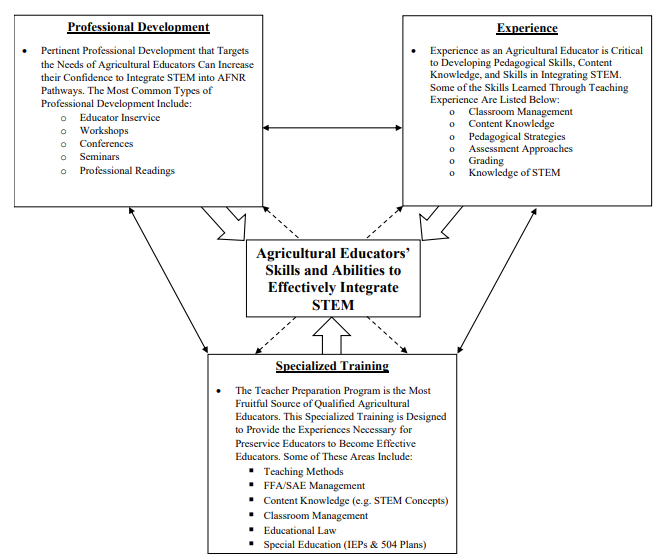
Note. Developed From Becker (1993).
Methods
Participants
This study utilized a descriptive correlational research design to assess the confidence levels of male and female agricultural educators in [State A], [State B], and [State C] to integrate STEM into their curriculum. The demographics of the participants are detailed in Table 1.
Table 1
Demographics of Participating Agricultural Educators in [State A], [State B], and [State C].
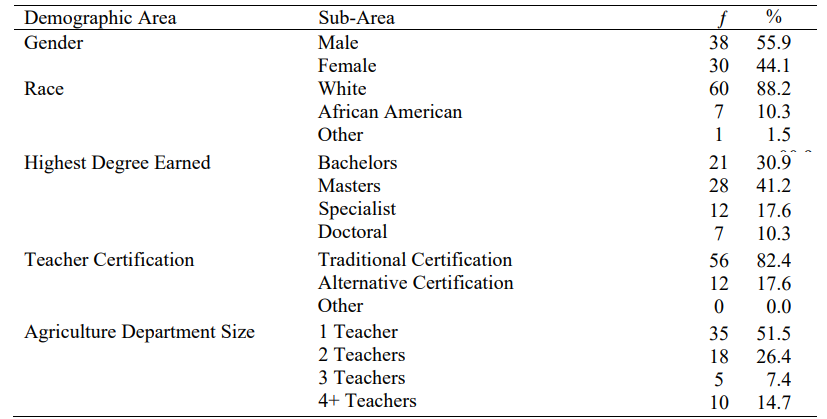
Note. n = 68
Of the most notable demographic information collected, 56.2% of participating agricultural educators were male, and 43.8% were female. Approximately 87.5% were white, and 10.9% were African American. Additionally, 59.4% of participants had a master’s degree or higher, and 81.3% were traditionally certified. Furthermore, 53.1% of participants taught in a one-teacher program.
Instrumentation
The instrument used in the study was delivered by Qualtrics to male and female agricultural educators, and it evaluated educators’ level of confidence to integrate specific STEM-based AFNR standards into agricultural education curriculum. The instrument was modified from Norris (2021). The statements regarding STEM were developed from the agriculture, food, and natural resources (AFNR) standards crosswalk produced by the National Council for Agricultural Education (2015). These AFNR standards were cross-walked with the Common Core Mathematics standards, Next Generation Science Standards, and the STEM sections of the Green/Sustainability Knowledge and Skill Statements to identify the STEM-based AFNR standards. The standards included in the instrument are listed in Table 3 by pathway. The statements were abbreviated from their original form for reporting purposes, but an effort was made to maintain the original intent. The confidence levels of agricultural educators were assessed using a Likert-type scale that ranged from 1 = Not Confident at All, 2 = Somewhat Confident, 3 = Moderately Confident, 4 = Very Confident, and 5 = Extremely Confident.
The researchers chose not to conduct a pilot study because the reliability and validity of the instrument were assessed by Norris (2021) in a previous pilot study. To further assess the instrument for this specific population, the researchers formed a panel of two faculty at [University] to assess the instrument for content, construct, and face validity. In addition, instrument reliability was assessed post hoc utilizing a Cronbach’s alpha reliability test on each pathway. The reliability coefficients for each pathway in the instrument ranged from .90 to .99. According to Ary et al. (2010), a reliability coefficient greater than .9 is considered an acceptable level of reliability. These results suggest there are no issues with the reliability or validity of the instrument.
Data Collection
A list of agricultural educators and their email addresses was collected using resources from online agricultural educator directories. This produced a list of 99 viable emails in [State A], 185 viable emails in [State B], and 115 viable emails in [State C] (N = 399). These states were purposively selected due to their close geographical proximity to each other and their similarities in SBAE programming. According to Ramsey and Schafer (2012), a total of 30 responses are needed for quality descriptive research. In this study, a response rate of 17.04% (n = 68) was achieved.
To evaluate non-response bias, the researchers employed independent samples t-tests to compare the differences between early responders and late responders (Lindner, et al., 2001). Following the approach suggested by Dillman et al. (2014) to elicit responses, participants were sent an introductory email, followed by three reminder emails. Those who responded after the initial introductory email (n = 28) were classified as early respondents, while those who responded after the three reminder emails (n = 40) were categorized as late respondents. No statistical differences were found, suggesting there are no non-response bias issues.
Data Analysis
To appropriately apply parametric statistics for the analysis of Likert scale data, it is necessary to group five or more items together to create constructs (Johnson & Creech, 1983; Norman, 2010; Sullivan & Artino, 2013; Zumbo & Zimmerman, 1993). This grouping is essential as Likert scale data is considered ordinal in nature. In this study, the STEM-based AFNR standards were combined to form constructs between each pathway. To evaluate research objective one, independent samples t-tests were utilized to assess statistical differences between the confidence levels of male and female agricultural educators to integrate STEM into the AFNR curriculum. In research objective two, central tendencies were utilized to further delineate the data and evaluate each individual STEM-based standard by the male and female agricultural educators’ confidence level to integrate each specific standard.
Limitations
Due to the limited response rate (17.04%), the researchers caution against generalizing these results beyond the participating agricultural educators. Moreover, despite the instrument’s robustness, it is improbable that it comprehensively assessed every STEM-based AFNR concept integrated into agricultural education.
Results
Research Objective One
Research objective one was assessed using independent samples t-tests on each AFNR pathway. The results of the independent samples t-test found statistically significant differences in the confidence levels of male and female agricultural educators to integrate STEM-based AFNR standards into the Environmental Services Pathway t(66) = 2.57, p = .01, Food Products and Processing Pathway t(66) = 2.38, p = .02, Natural Resources Pathway t(66) = 2.23, p = .03, Plant Systems Pathway t(66) = 1.95, p =.05, and the Power, Structural, and Technical Systems Pathway t(66) = 7.13, p < .001. The Agribusiness Pathway t(66) = 1.89, p = .06, Animal Science Pathway t(66) = .24, p = .82, and the Biotechnology Pathway t(66) = .33, p = .74 all had statistically insignificant effects. According to Cohen (1988), Cohen’s d is interpreted as a small effect = .20, medium effect = 0.50, and a large effect = .80. The analysis suggested that the Environmental Services Pathway (Cohen’s d = .63), Food Products and Processing Pathway (Cohen’s d = .58), Natural Resources Pathway (Cohen’s d = .56), and the Plant Systems Pathway (Cohen’s d = .48) all had moderate effect sizes (Cohen, 1988). In addition, the Power, Structural, and Technical Systems Pathway (Cohen’s d = 1.74) had a large effect size (Cohen, 1988). The complete results of the t-tests are reported in Table 2.
Table 2
Results for the t-test Assessing STEM Integration Confidence of Male and Female Educators
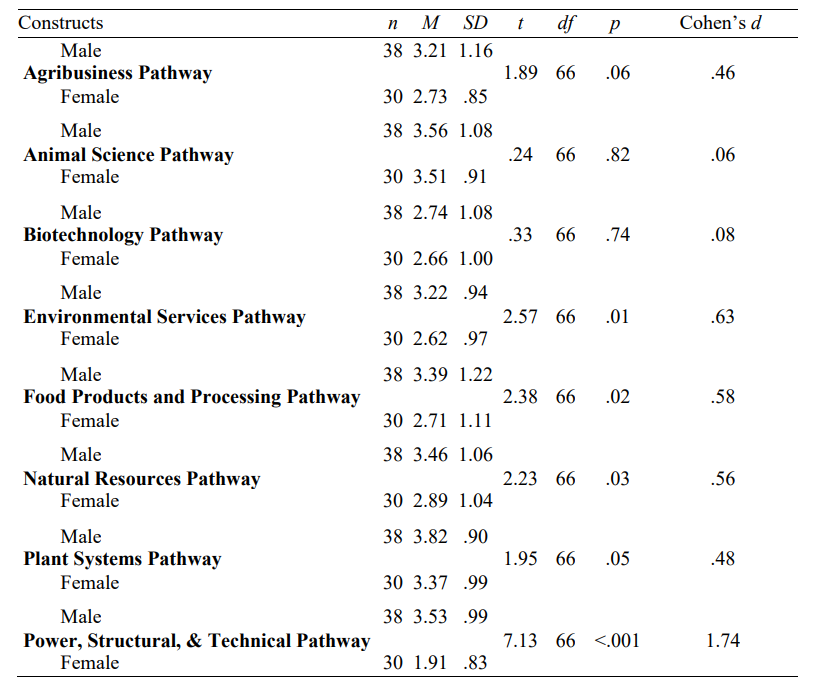
Note. Α = .05. Cohen’s d is interpreted as a small effect = .20, medium effect = 0.50, and a large effect = .80. The Likert scale ranges from 1 = Not Confident at All, 2 = Somewhat Confident, 3 = Moderately Confident, 4 = Very Confident, and 5 = Extremely Confident.
Research Objective Two
Research objective two aimed to further delineate the data by evaluating differences in male and female agricultural educators’ confidence to implement each individual STEM-based AFNR standard. The results from research objective two are reported in Table 3.
Table 3
Descriptive Statistics Describing the Individual STEM-based AFNR Standards by Sex
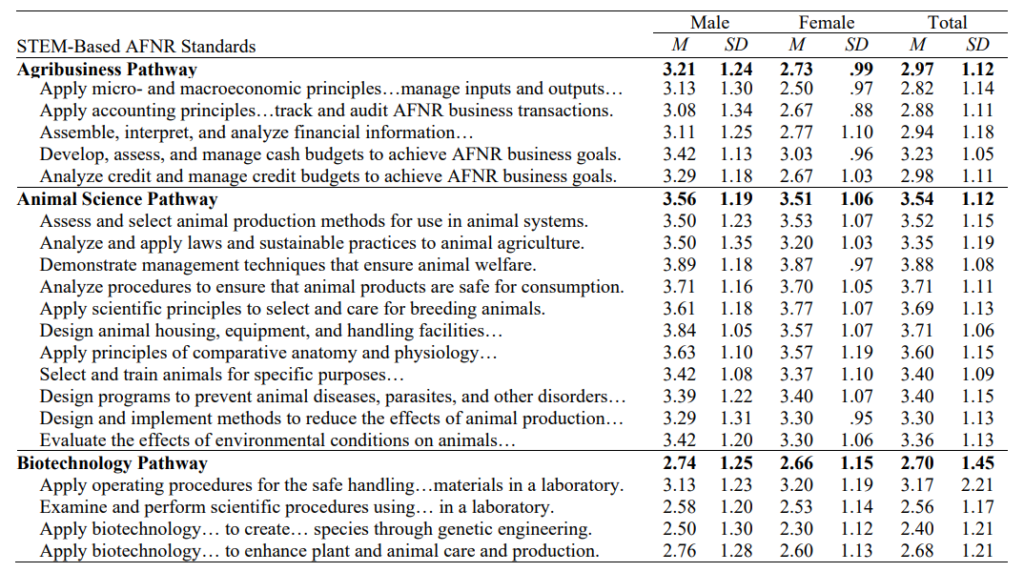
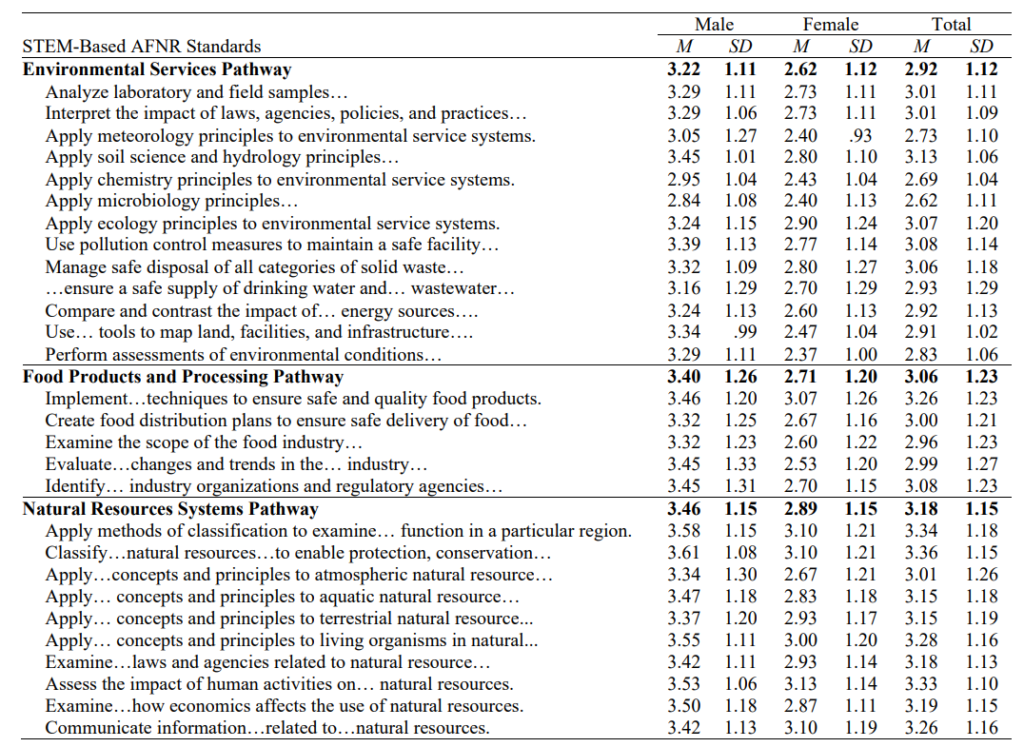
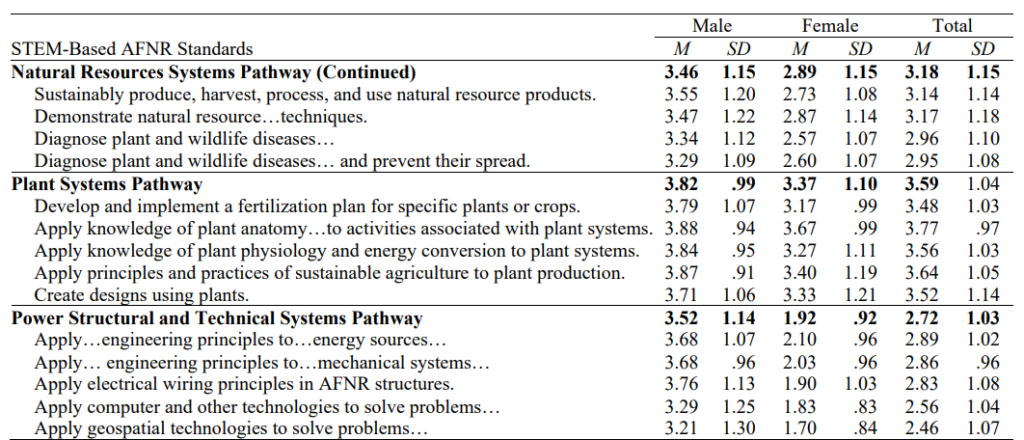
Note. 1 = Not Confident at All, 2 = Somewhat Confident, 3 = Moderately Confident, 4 = Very Confident, and 5 = Extremely Confident
Within the Agribusiness Pathway, both male and female agricultural educators rated “Develop, assess and manage cash budgets to achieve AFNR business goals” (Male, M = 3.42, SD = 1.13; Female, M = 3.03, SD = .96) as the standard they were the most confident in implementing. Male and female agricultural educators both ranked “Demonstrate management techniques that ensure animal welfare” (Male, M = 3.89, SD = 1.18; Female, M = 3.87, SD = .97) the highest within the Animal Science Pathway. Within the Biotechnology Pathway, male and female participating agricultural educators both selected “Demonstrate management techniques that ensure animal welfare” (Male, M = 3.13, SD = 1.23; Female, M = 3.20, SD = 1.19) as the standard they were most confident in implementing. Within the Environmental Science Pathway, male agricultural educators ranked “Demonstrate management techniques that ensure animal welfare” (M = 3.45, SD = 1.01) as the standard they had the most confidence in implementing, but female agricultural educators ranked “Apply ecology principles to environmental service systems” as the highest standard (M = 3.24, SD = 1.15). The male and female agricultural educators both ranked “Implement selection, evaluation and inspection techniques to ensure safe and quality food products” (Male, M = 3.46, SD = 1.20; Female, M = 3.07, SD = 1.26) as the Food Products and Processing Pathway standard they had the most confidence in implementing. Within the Natural Resources Pathway, the male agricultural educators ranked “Classify different types of natural resources in order to enable protection, conservation, enhancement, and management in a particular geographical region” (M = 3.61, SD = 1.08) as the standard they felt the most confident in implementing, while female agricultural educators selected “Assess the impact of human activities on the availability of natural resources” (M = 3.13, SD = 1.14) as the standard they felt the most confidence in implementing. Male and female agricultural educators both selected “Apply knowledge of plant anatomy and the functions of plant structures to activities associated with plant systems” as the STEM-based standard in the Plant Systems Pathway they were the most confident in implementing. Within the Power, Structural, and Technical Systems Pathway, the male agricultural educators selected “Apply electrical wiring principles in AFNR structures” (M = 3.76, SD = 1.13) as the STEM-based standard they felt the most confident in integrating, while the female agricultural educators selected “Apply physical science and engineering principles to assess and select energy sources for AFNR power, structural and technical systems” (M = 2.10, SD = .96) as the standard they were the most confident in implementing.
Discussions, Conclusions, and Recommendations
Throughout agricultural education’s history, ensuring a prepared and competent workforce has been a major objective (Fristoe, 2017; Martinez, 2007). It is noted throughout the published literature that STEM skills are a critical component of a workplace (Scherer et al., 2019; Swafford, 2018). While STEM skills are vital to success, the industry currently claims that students exiting secondary education are not adequately prepared in the areas of STEM (McGunagle & Zizka, 2020). In addition, many studies suggest that women are choosing not to major in STEM (Beede et al., 2011; Bloodhart et al., 2020; Koch et al., 2022) and are not entering STEM-based career fields (Beede et al., 2011).
The first research objective assessed statistical differences between the confidence levels of male and female agricultural educators to integrate STEM into the AFNR curriculum. Overall, statistical differences were found in five of the eight pathways including the Environmental Services, Food Products and Processing, Natural Resources, Plant Systems, and the Power, Structural, and Technical Systems pathways. This result was consistent with Smith et al. (2015), who found that female agricultural educators have less confidence in integrating engineering into agricultural education. This is particularly concerning for the agricultural education profession since the number of female agricultural educators has increased exponentially over the last 50+ years (Enns & Martin, 2015).
The second research objective further delineated the data by evaluating each STEM-based AFNR standard for differences in the confidence levels of male and female agricultural educators to integrate STEM. Overall, male participants selected the Plant Science, Animal Science, and Power, Structural, and Technical Systems pathways as the areas they were the most confident in integrating STEM. Inversely, the areas that male agricultural educators had the least amount of confidence in integrating STEM were the Biotechnology, Agribusiness, and Environmental Services pathways. Female agricultural educators reported being the most confident in integrating STEM into the Animal Science, Plant Systems, and Natural Resources pathways. Furthermore, female agricultural educators ranked the Power, Structural, and Technical Systems, Environmental Science, and Biotechnology pathways as the areas they felt least confident in implementing STEM. Overall, male and female agricultural educators ranked two of the same pathways as the highest and two of the same pathways the lowest. The most significant difference in this objective was the large variations in confidence within the Power, Structural, and Technical Systems pathway. This result is consistent with Yopp et al. (2020) who found statistically significant differences in the professional development needs of female and male agricultural educators within the Power, Structural, and Technical Systems pathway.
Based on the results of this study, the researchers recommend providing agricultural educators with targeted professional development on STEM integration. For example, professional development for female agricultural educators within the Power, Structural, and Technical pathway may be beneficial to increase their confidence in integrating STEM into the AFNR curriculum. This targeted and pertinent professional development will help increase the human capital input for agricultural educators (Becker, 1993).
Recommendations for future research include evaluating teacher preparation programs’ STEM integration training and assessing the current professional development options for agricultural educators. Additionally, Fernandez et al. (2020) found that there will be a continued demand for employees in AFNR jobs, but there is a lack of students trained specifically in STEM and AFNR fields at the postsecondary level. Furthermore, the pool of available college graduates trained in STEM and AFNR lacks diverse representation (Fernandez et al., 2020). To counter these findings, the researchers recommend assessing the confidence levels of agricultural educators who teach STEM in traditionally underserved populations. To improve the pipeline of future AFNR employees, it is important to measure these agricultural educators’ abilities and confidence levels to integrate STEM into agricultural education curriculum. By improving the exposure to and training of STEM and AFNR careers in secondary education, interest and involvement from underserved populations could increase at the postsecondary level for a diverse AFNR workforce (Burt & Johnson, 2018; Maltese et al., 2014; Maltese & Tai, 2010; Williams et al., 2016).
References
Ary, D., Jacobs, L. C., Sorensen, C. K., & Walker, D. A. (2010). Introduction to research in education (8th ed.). Wadsworth, Cengage Learning.
Becker, G. S. (1964). Human capital: A theoretical and empirical analysis with special reference to education. National Bureau of Economic Research.
Becker, G. S. (1993). Human capital: A theoretical and empirical analysis with special reference to education (3rd ed.). The University of Chicago Press.
Beede, D. N., Julian, T. A., Langdon, D., McKittrick, G., Khan, B., & Doms, M. E. (2011). Women in STEM: A gender gap to innovation. Economics and Statistics Administration Issue Brief, 4(11), 1-11. http://dx.doi.org/10.2139/ssrn.1964782
Bloodhart, B., Balgopal, M. M., Casper, A. M., McMeeking, L. B., & Fischer, E. V. (2020). Outperforming yet undervalued: Undergraduate women in STEM. Plos One, 15(6), 1-13. https://doi.org/10.1371/journal.pone.0234685
Burt, B. A., & Johnson, J. T. (2018). Origins of early STEM interest for Black male graduate students in engineering: A community cultural wealth perspective. School Science and Mathematics, 118(6), 257-270. http://dx.doi.org/10.1111/ssm.12294
Chiasson, T. C., & Burnett, M. F. (2001). The influence of enrollment in agriscience courses on the science achievement of high school students. Journal of Agricultural Education, 42(1), 61-71. http://dx.doi.org/10.5032/jae.2001.01061
Chumbley, S. B., Haynes, J. C., & Stofer, K. A. (2015). A measure of students’ motivation to learn science through agricultural STEM emphasis. Journal of Agricultural Education, 56(4), 107-122. https://doi.org/10.5032/jae.2015.04107
Clark, S., Parr, B., Peake, J., & Flanders, F. (2013). Correlation of secondary agricultural education students’ science achievement to FFA and supervised agricultural axperience participation. Journal of Southern Agricultural Education Research, 63(1), 72-85. https://citeseerx.ist.psu.edu/document?repid=rep1&type=pdf&doi=ae39290af6cdea6aa35ce0d215e2c257652eb2ed
Cohen, J. (1988). Statistical power analysis for the behavioral sciences. Lawrence Erlbaum Associates, Publishers.
Dillman, D. A., Smyth, J. D., & Christian, L. M. (2014). Internet, phone, mail, and mixed-mode surveys: The tailored design method. John Wiley & Sons.
Eck, C., Robinson, J. S., Cole, K., Terry, R., & Ramsey, J. (2021). Identifying the characteristics of effective school-based agricultural education teachers: A national census study. Journal of Agricultural Education, 62(3), 292–309. https://doi.org/10.5032/jae.2021.03292
Eck, C. J., Robinson, J. S., Cole, K. L., Terry, J. R., & Ramsey, J. W. (2020). The validation of the effective teaching instrument for school-based agricultural education teachers. Journal of Agricultural Education, 61(4), 229–248. http://doi.org/10.5032/jae.2020.04229
Eck, C. J., Robinson, J. S., Ramsey, J. W., & Cole, K. L. (2019). Identifying the characteristics of an effective agricultural education teacher: A national study. Journal of Agricultural Education, 60(4), 1-18. http://dx.doi.org/10.5032/jae.2019.04001
Enns, K. J., & Martin, M. J. (2015). Gendering agricultural education: A study of historical pictures of women in the agricultural education magazine. Journal of Agricultural Education, 56(3), 69–89. https://doi.org/10.5032/jae.2015.03069
Fernandez, J.M., Goecker, A.D., Smith, E., Moran, E.R., & Wilson, C.A. (2020). Employment opportunities for college graduates in food, agriculture, renewable natural resources for the environment: United States, 2020-2025. United States Department of Agriculture. https://www.purdue.edu/usda/employment/
Frióna, D., Szenderák, J., & Harangi-Rákos, M. (2019). The challenge of feeding the world. Sustainability, 11(20), 1-18. https://doi.org/10.3390/su11205816
Fristoe, A. (2017). Smith-Hughes Act transforms agricultural education. Techniques: Connecting Education & Careers, 92(2), 37-53. http://digital.graphcompubs.com/article/Smith-Hughes+Act+Transforms+ Agricultural+Education/2688544/377016/article.html#
Johnson, D. R., & Creech, J. C. (1983). Ordinal measures in multiple indicator models: A simulation study of categorization error. American Sociological Review, 48(3), 398–407. https://doi.org/10.2307/2095231
Kelly, T., & Knowles, G. (2016). A conceptual framework for integrated STEM education. International Journal of STEM Education, 3(11), 1-11. https://doi.org10.1186/s40594-016-0046-z
Koch, A. J., Sackett, P. R., Kuncel, N. R., Dahlke, J. A., & Beatty, A. S. (2022). Why women STEM majors are less likely than men to persist in completing a STEM degree: More than the individual. Personality and Individual Differences, 190, 116-121. https://doi.org/10.1016/j.paid.2022.111532
Lindner, J. R., Murphy, T. H., & Briers, G. E. (2001). Handling nonresponse in social science research. Journal of Agricultural Education, 42(4), 43-53. http://dx.doi.org/10.5032/jae.2001.04043
Maltese, A. V., Melki, C. S., & Wiebke, H. L. (2014). The nature of experiences responsible for the generation and maintenance of interest in STEM. Science Education, 98(6), 937–962. http://dx.doi.org/10.1002/sce.21132
Maltese, A. V., & Tai, R. H. (2010). Eyeballs in the fridge: Sources of early interest in science. International Journal of Science Education, 32(5), 669–685. http://dx.doi.org/10.1080/09500690902792385
Martinez, R. (2007). An evolving set of values-based principles for career and technical education. Journal of Career and Technical Education, 23(1), 72-84. https://files.eric.ed.gov/fulltext/EJ901311.pdf
McGunagle, D., & Zizka, L. (2020). Employability skills for 21st-century STEM students: the employers’ perspective. Higher education, Skills and Work-based Learning, 10(3), 591-606. https://doi.org/10.1108/ HESWBL-10-2019-0148
McKim, A. J., Velez, J. J., & Sorensen, T.J. (2018). A national analysis of school-based agricultural education involvement, graduation, STEM achievement, and income. Journal of Agricultural Education, 59(1), 70-85. https://doi.org/10.5032/jae.2018.01070
National Council for Agricultural Education. (2015). Agriculture, food, and natural resource crosswalks. https://ffa.app.box.com/s/n6jfkamfof0spttqjvhddzolyevpo3qn/file/294149331493
Nolin, J. B., & Parr, B. (2013). Utilization of a high stakes high school graduation exam to assess the impact of agricultural education: A measure of curriculum integration. Journal of Agricultural Education, 54(3), 41-53. http://dx.doi.org/10.5032/jae.2013.03041
Norman, G. (2010). Likert scales, levels of measurement and the “laws” of statistics. Advances in Health Sciences Education, 15(5), 625–632. http://dx.doi.org/10.1007/s10459-010-9222-y
Norris, J. W. (2021). Perceptions of career and technical education administrators on STEM and employability skills integration into school based agricultural education. [Doctoral Dissertation, Mississippi State University]. https://scholarsjunction.msstate.edu/td/5129/
Plank, S. (2001). Career and technical education in the balance: An analysis of high school persistence, academic achievement, and postsecondary destinations. National Research Center for Career and Technical Education. https://files.eric.ed.gov/fulltext/ED461721.pdf
Ramsey, F., & Schafer, D. (2012). The statistical sleuth: A course in methods of data analysis. Cengage Learning.
Scherer, H. H., McKim, A. J., Wang, H.-H., DiBenedetto, C. A., & Robinson, K. (2019). Making sense of the buzz: A systematic review of “STEM” in agriculture, food, and natural resources education literature. Journal of Agricultural Education, 60(2), 28-53. http://dx.doi.org/10.5032/jae.2019.02028
Smith, E. (2010). Sector–specific human capital and the distribution of earnings. Journal of Human Capital, 4(1), 35–61. https://doi.org/10.1086/655467
Smith, K. L., Rayfield, J., & McKim, B. R. (2015). Effective practices in STEM integration: Describing teacher perceptions and instructional method use. Journal of Agricultural Education, 56(4), 182-201. http://dx.doi.org/10.5032/jae.2015.04183
Smylie, M. A. (1996). From bureaucratic control to building human capital: The importance of teacher learning in education reform. Educational Researcher, 25(9), 9–11. https://doi.org/10.3102/0013189X025009009
Stubbs, E. A., & Myers, B. E. (2016). Part of what we do: Teacher perceptions of STEM integration. Journal of Agricultural Education, 57(3), 87-100. http://dx.doi.org/10.5032/jae.2016.0308
Sullivan, G. M., & Artino, A. R. (2013). Analyzing and interpreting data from Likert-type scales. Journal of Graduate Medical Education, 5(4), 541–542. https://doi.org/10.4300/JGME-5-4-18
Swafford, M. (2018). STEM education at the nexus of the 3-circle model. Journal of Agricultural Education, 59(1), 297-315. https://doi.org/10.5032/jae.2018.01297
Theriot, P. J., & Kotrlik, J. W. (2009). Effect of enrollment in agriscience on students’ performance in science on the high school graduation test. Journal of Agricultural Education, 50(4), 72-85. http://dx.doi.org/10.5032/jae.2009.04072
Wang, H., & Knobloch, N. (2020). Preservice educators’ beliefs and practices of teaching STEM through agriculture, food, and natural resources. Journal of Agricultural Education, 61(2), 57-76. https://doi.org/10.5032/jae.2020.02057
Williams, K., Burt, B. A., & Hilton, A. (2016). Math achievement: A role strain and adaptation approach. Journal for Multicultural Education, 10(3), 368–383. https://doi.org/10.1108/JME-01-2016-0005
Yopp, A. M., Edgar, D., & Croom, D. B. (2020). Technical in-service needs of agriculture teachers in Georgia by career pathway. Journal of Agricultural Education, 61(2), 1–19. https://doi.org/10.5032/jae.2020.02001
Zumbo, B. D., & Zimmerman, D. W. (1993). Is the selection of statistical methods governed by level of measurement? Canadian Psychology, 34(1), 390–400. https://doi.org/10.1037/h0078865